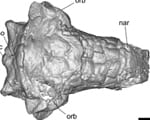New holes are also developing to join them, a satellite study shows.
Online news site Seeker.com covered the research of SMU geophysicists Zhong Lu, professor, Shuler-Foscue Chair, and Jin-Woo Kim research scientist, both in the Roy M. Huffington Department of Earth Sciences at SMU. Seeker.com’s article, “Giant Sinkholes Near Texas Oil Fields Are Growing,” published June 16, 2016.
The Dedman College geophysicists are co-authors of a new analysis using satellite radar images to reveal ground movement of two giant sinkholes near Wink, Texas. They found that the movement suggests the two existing holes are expanding, and new ones are forming as nearby subsidence occurs at an alarming rate.
Lu is world-renowned for leading scientists in InSAR applications, short for a technique called interferometric synthetic aperture radar, to detect surface changes that aren’t visible to the naked eye. Lu is a member of the Science Definition Team for the dedicated U.S. and Indian NASA-ISRO InSAR mission, set for launch in 2020 to study hazards and global environmental change.
InSAR accesses a series of images captured by a read-out radar instrument mounted on the orbiting satellite Sentinel-1A. Sentinel-1A was launched in April 2014 as part of the European Union’s Copernicus program.
Lu and Kim reported the findings in the scientific journal Remote Sensing, in the article “Ongoing deformation of sinkholes in Wink, Texas, observed by time-series Sentinel-1A SAR Interferometry.”
The research was supported by the U.S. Geological Survey Land Remote Sensing Program, the NASA Earth Surface & Interior Program, and the Shuler-Foscue Endowment at Southern Methodist University.
EXCERPT:
Seeker.com
In west Texas, they call them the “Wink Sinks.” They’re two giant sinkholes between the towns of Wink and Kermit, the after-affect of a lot of oil being pumped out of the ground in the area more than 60 years ago. And now researchers have discovered that the oddball landmarks — already the size of multiple football fields — are unstable and likely to grow even bigger.Southern Methodist University geophysicists utilized a time series of radar images captured by an orbiting satellite 435 miles overhead to study the sinkholes. They used a technique called interferometric synthetic aperture radar, or InSAR, to detect changes that aren’t visible to a person at ground level.
Their study, published in the journal Remote Sensing, found that the extent of subsidence in the area has increased significantly over the past seven years, and that the instability originally caused by oil drilling now is being driven by changing groundwater levels.
As the groundwater increases, it dissolves a massive underground salt formation in the area, which then causes the ground to sink.
That’s a problem, because the Wink Sinks already are pretty big. Wink Sink No. 1, which is closer to the town of Kermit, has grown since 1980 to 361 feet across. Wink Sink No. 2, which is nine-tenths of a mile to the south, is about 900 feet across at its widest point.
But to make matters worse, other parts of the area around the sinkholes is sinking as well. The highest rate of ground subsidence is in an area about seven-tenths of a mile northeast of No. 2, which is collapsing at a rate of more than 5 inches per year.
“This area is heavily populated with oil and gas production equipment and installations, hazardous liquid pipelines, as well as two communities,” research scientist Jin-Woo Kim, who co-authored the study with SMU professor Zhong Lu, explained in a press release. He explained that a more massive collapse “could be catastrophic.”
Follow SMU Research on Twitter, @smuresearch.
For more SMU research see www.smuresearch.com.
SMU is a nationally ranked private university in Dallas founded 100 years ago. Today, SMU enrolls nearly 11,000 students who benefit from the academic opportunities and international reach of seven degree-granting schools. For more information, www.smu.edu.
SMU has an uplink facility located on campus for live TV, radio, or online interviews. To speak with an SMU expert or book an SMU guest in the studio, call SMU News & Communications at 214-768-7650.


 To request an interview with Zhong Lu call SMU News and Communications at 214-768-7650 or email SMU News at
To request an interview with Zhong Lu call SMU News and Communications at 214-768-7650 or email SMU News at  To request an interview with Jin-woo Kim call SMU News and Communications at 214-768-7650 or email SMU News at
To request an interview with Jin-woo Kim call SMU News and Communications at 214-768-7650 or email SMU News at  Early armored dino from Texas lacked cousin’s club-tail weapon, but had a nose for danger
Early armored dino from Texas lacked cousin’s club-tail weapon, but had a nose for danger SMU physicists: CERN’s Large Hadron Collider is once again smashing protons, taking data
SMU physicists: CERN’s Large Hadron Collider is once again smashing protons, taking data Nearby massive star explosion 30 million years ago equaled brightness of 100 million suns
Nearby massive star explosion 30 million years ago equaled brightness of 100 million suns Text in lost language may reveal god or goddess worshipped by Etruscans at ancient temple
Text in lost language may reveal god or goddess worshipped by Etruscans at ancient temple Good news! You’re likely burning more calories than you thought
Good news! You’re likely burning more calories than you thought